June 28, 2023

Cooking Up a Storm: How VSM and Systems Thinking Fuel Success

Written by: Marie Kalliney
Introduction: on operational excellence in dining, and enterprise IT
In my current professional life, I’m focused on helping global organizations optimize and accelerate the flow of value. In a prior life, I was focused on a different kind of value—the delivery of a fine dining experience. At that time, I was a line cook at a high-end restaurant in New York city.
I didn’t realize it at the time, but through that experience, I was actually taking a master class in systems thinking and value stream management (VSM).
Because of my prior work experience, when I get the chance to dine at a high-end restaurant, I may have a deeper appreciation than most for all the work that goes on behind the scenes.
When restaurateurs get it right, the dining experience can be an absolute delight. A lot goes into that experience—a tremendous amount of preparation, a lot of skill, sustained commitment, and timely execution. Ultimately, a lot of responsibility rests with the master chef, the one who assembles and fuses all the different elements created by other cooks and melds them together to create something that’s both beautiful and delicious.
How does all this relate to systems thinking and VSM?
With systems thinking, you need to take a step back and look at the big picture and understand all the connections and interdependencies. In this way, for example, you can see how running out of an essential ingredient or receiving poor-quality source materials at one end of the cycle can have a significant impact on what ultimately gets delivered to the customer.
With VSM, it’s about optimizing the flow of value to customers. Just like the master chef delivering dining experiences, enterprise IT teams need to deliver quality experiences and exceptional value to their customers. Just like their counterparts in the restaurant, these teams need to eliminate bottlenecks and delays, use staff and ingredients/resources efficiently, and collaborate and stay in sync with colleagues.
I view VSM and systems thinking not just as complementary, but inextricably bound. Ultimately, you can’t have true VSM without systems thinking. Fundamentally, you need to have a holistic view of an entire system and use that to guide continuous optimization.
Harnessing the power of systems thinking and VSM: 5 success patterns
By pulling together the power of systems thinking and VSM, teams can gain a clearer understanding of their operations, better understand customers, boost efficiency and profitability, and deliver more customer value. Ultimately, through systems thinking and VSM, teams can achieve operational excellence.
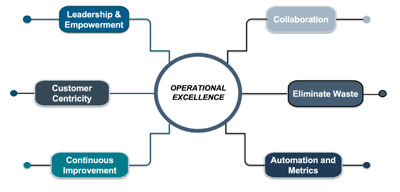 In working with our global enterprise clients, I’ve found there are several patterns that successful teams exhibit. Here are the top traits of these successful teams.
In working with our global enterprise clients, I’ve found there are several patterns that successful teams exhibit. Here are the top traits of these successful teams.
Lead and empower teams
To start, it’s vital that leaders model behavior they want to see their teams exhibit. It is also important to empower employees and trust them to be able to execute, rather than trying to micromanage their daily activities.
Ask team members for input. Put an effort into cultivating collaboration and building an open, trusting relationship. Celebrate victories when they’re achieved, even the small ones, and be sure to show gratitude for the efforts being made.
Take a customer-centric approach
Customers really are like royalty; it is important to treat them that way. (Note, within the context of VSM and systems thinking, “customers” can refer to internal clients or external customers.)
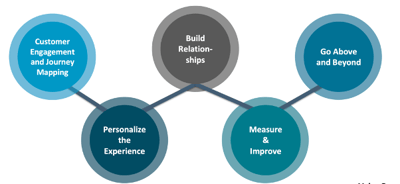 Ultimately, you want to get a clear picture of what value means to the customer, and how you can deliver more value. Often, it is important to start by mapping the customer journey, and begin to truly collaborate with customers. This is the only way you’ll be able to understand what it is they really value. Ultimately, it is about establishing a relationship—not simply doing a survey and moving on.
Ultimately, you want to get a clear picture of what value means to the customer, and how you can deliver more value. Often, it is important to start by mapping the customer journey, and begin to truly collaborate with customers. This is the only way you’ll be able to understand what it is they really value. Ultimately, it is about establishing a relationship—not simply doing a survey and moving on.
With this understanding, teams can start to determine how to deliver better, more personalized, and higher-value experiences. Finally, it is important to take a holistic, all-encompassing approach. Returning to the dining analogy, think about how everything matters. Lighting, silverware, furniture, artwork, and more can all either enhance or degrade the diner’s experience.
Establish cross-team collaboration
Cross-functional collaboration is key to the success of the IT organization. Team leads should start by setting common goals and priorities and then gaining alignment around those targets.
Next, examine all the interdependent relationships through a holistic, systems-thinking approach. Once you understand all the key dependencies, identify where teams are still working in silos and start to integrate those teams.
Eliminate waste
Borrowing from lean models, it is important to weed out waste. Start by identifying those activities that deliver value, and those that don’t. For those activities that don’t deliver value, you can look to automate, deprecate, or eliminate.
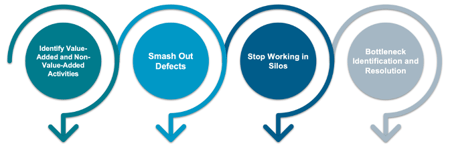 It is also important to make a concerted effort to remove defects. While focusing on defects is not glamorous work, it can be essential. Not only is it a great way to boost efficiency, but it can be a key to an enhanced experience. For example, if we’re shopping online at a new vendor site, and we experience a glitch, we’re highly likely to abandon and move to another site, especially before we entrust our payment details and other sensitive info. For IT operations teams, weeding out those sales- and experience-eroding defects is imperative.
It is also important to make a concerted effort to remove defects. While focusing on defects is not glamorous work, it can be essential. Not only is it a great way to boost efficiency, but it can be a key to an enhanced experience. For example, if we’re shopping online at a new vendor site, and we experience a glitch, we’re highly likely to abandon and move to another site, especially before we entrust our payment details and other sensitive info. For IT operations teams, weeding out those sales- and experience-eroding defects is imperative.
Look to identify and resolve the bottlenecks that hinder value delivery. Silos can also sap organizational efficiency. Look at where silos may exist, and figure out a plan for removing them. Organizing and aligning teams around value streams can be indispensable in this effort.
Pursue continuous improvement
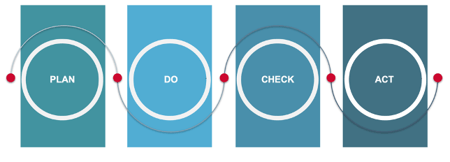 On a continuous basis, it is essential to measure the customer experience and keep trying to move the needle in making improvements.
On a continuous basis, it is essential to measure the customer experience and keep trying to move the needle in making improvements.
For many teams, the plan, do, check, and act model can be a great approach to fuel these gains. Following is a high-level overview of each step:
- Plan. Effectively, teams need to establish their hypothesis, and build a plan for testing that hypothesis.
- Do. Next, teams execute the functionality required based on the hypothesis established.
- Check. Then teams need to measure the work delivered and see whether it validated or invalidated the hypothesis.
- Act. Once work meets the hypothesis, you then release the functionality. If it doesn’t meet the hypothesis, you go back to the plan phase and try again.
Leverage automation and metrics
To be successful, it is important for teams to have the flexibility to work with the tools they want. However, at the same time, it is absolutely essential that data from the various tools employed needs to be integrated.
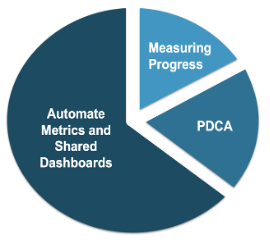 This is why investing in tools that can help facilitate these integrations is essential, particularly for teams new to VSM. The sooner these investments are made, the better off teams are. Initial data being captured can be instrumental in fueling early iterations that set initiatives moving in the right direction.
This is why investing in tools that can help facilitate these integrations is essential, particularly for teams new to VSM. The sooner these investments are made, the better off teams are. Initial data being captured can be instrumental in fueling early iterations that set initiatives moving in the right direction.
Teams need to be able to gain real-time access to both high-level and low-level data. This data is integral in enabling teams to effectively measure progress and continuously improve. If teams have to manually compile data in spreadsheets or basic databases, they’ll lack the timely insights required—and they’ll spend too much time and effort on tracking and reporting.
Conclusion
By establishing these winning patterns, I’ve seen organizations boost employee morale, improve customer satisfaction, increase sales, reduce costs, and more. To learn more about how organizations can achieve these results, be sure to download a new Harvard Business Review Analytic Services Report on data-driven transformation with value stream management.

Marie Kalliney
Marie, who is "All Agile All the Time" (AAATT), serves as the Practice Director for ValueOps Professional Services and is a frequent content creator on the power of leadership. Marie's team of digital advisory consultants guides our clients through their Value Stream Management journey, driving business outcomes and...
Other resources you might be interested in
Top 3 Trends Defining Network Observability in 2026
Discover the three specific trends that will define network observability in 2026. See how unified observability and predictive AI will shape the landscape.
Rally Office Hours: December 18, 2025
Rally Office Hours features an AI-driven artifact breakdown tool that creates child items from features/stories. The Q&A covers capacity planning, forecasting and burnup charts.
Why 2025 Shattered the Old Rules of Network Management
This post reveals the five key lessons network operations leaders learned in 2025—and how they need to respond to be successful in 2026.
The 2026 VMUG Report: Why Network Observability is the Heart of the New VCF Era
Get the top takeaways from the VMUG Cloud Operations and VCF User Experience Report 2026. See why network observability is key to successful VCF 9 migrations.
Automic Automation Cloud Integration: SAP S/4 HANA Application Jobs Integration
Simplify your SAP S/4HANA job management. Integrate with Automic Automation for central configuration, monitoring, and orchestration of all your enterprise jobs.
Automic Automation Cloud Integration: OpenSSH Integration
Master Open SSH automation. Use Automic Automation for centralized control, secure file transfer, command execution, and full job monitoring.
Rally Office Hours: December 11, 2025
Discover Rally's new Ancestors field, static query box deprecation, non-conflicting saves, plus a dashboard demo and query writing tips.
3 Questions I Expect You to Ask Me
Ask these questions to gain a deeper understanding of a vendor. Find a partner who can solve today’s challenges and prepare you for what’s next.
Carrier-Grade Network Observability: A Technology Brief for Telco Network Operations
Network Observability by Broadcom unifies data to provide contextual, AI-enabled insights for superior service availability, accelerated MTTR and improved MTTI, reduced operational costs, and the...